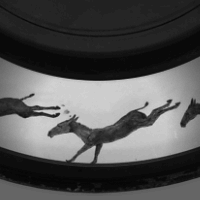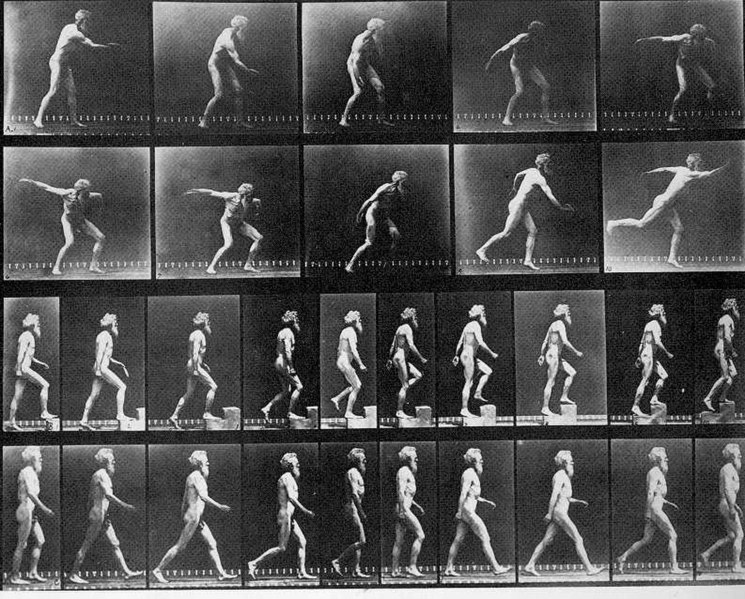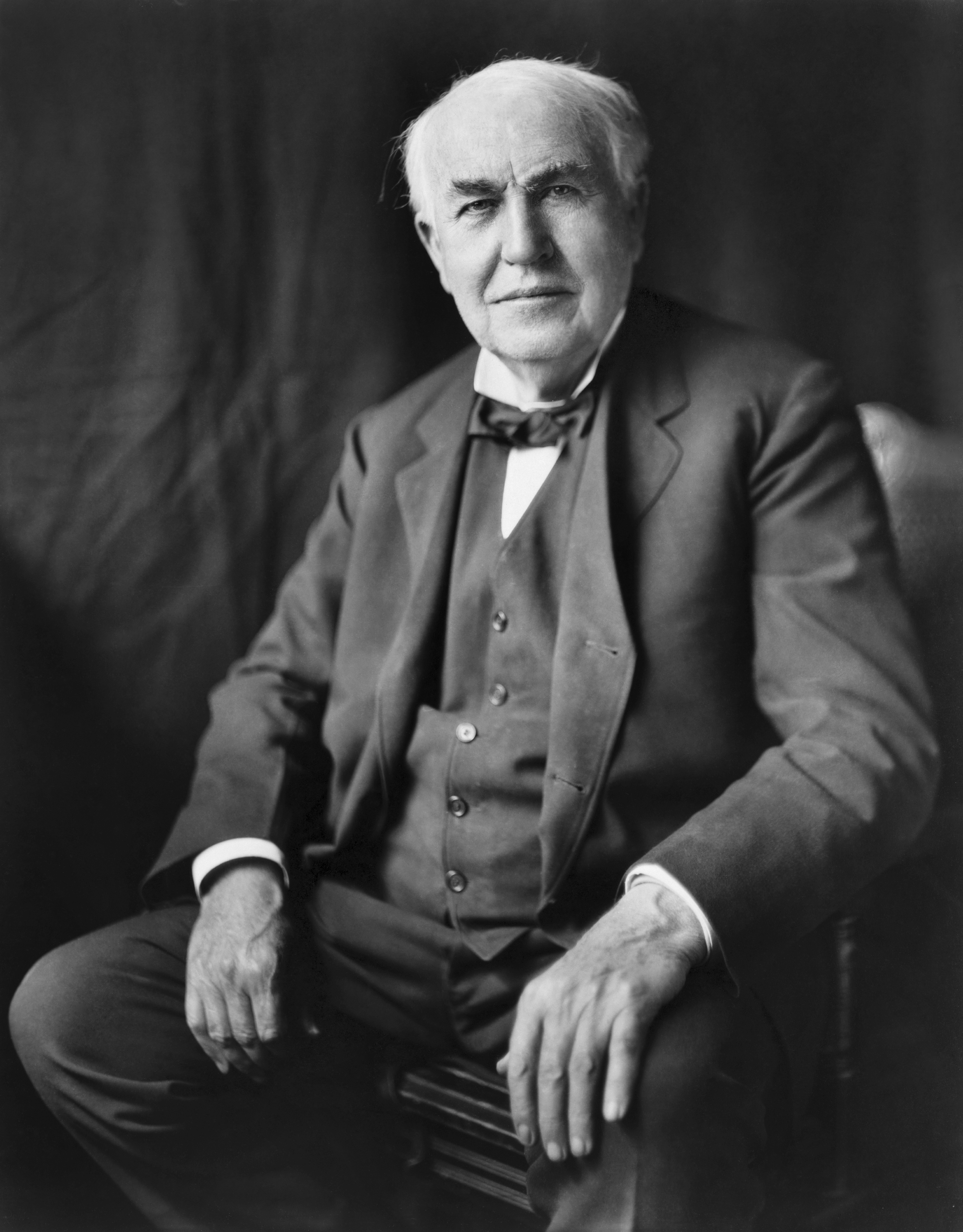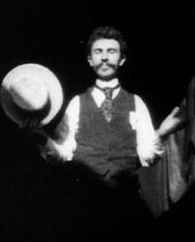For suggested
movies
Click Here.
PRESENTATION
 Edweard
Muybridge
Edweard
Muybridge
(April 9, 1830 – May 8, 1904) was an English photographer,
known primarily for his early use of multiple cameras to
capture motion, and his zoopraxiscope, a device for
projecting motion pictures that pre-dated the celluloid film
strip.


A
popularly-debated question of the day was
whether all four of a horse's hooves left the
ground at the same time during a gallop. Leland
Stanford (the Governor of California) sided with
this assertion - called unsupported transit.
He hired Muybridge to settle the question.
In 1878 Muybridge photographed a horse in fast
motion using a series of twenty-four cameras.
Trip-wires attached to each camera's
shutter were triggered by the horse's hooves.

Muybridge
started by photographing landscaped of Yosemite and San
Francisco.
 At
the Chicago 1893 World's Columbian Exposition, Muybridge
gave a series of lectures on the Science of Animal
Locomotion in the Zoopraxographical Hall - built specially
for that purpose. He used his zoopraxiscope to show his
moving pictures to a paying public. This was the very
first commercial movie theater.
At
the Chicago 1893 World's Columbian Exposition, Muybridge
gave a series of lectures on the Science of Animal
Locomotion in the Zoopraxographical Hall - built specially
for that purpose. He used his zoopraxiscope to show his
moving pictures to a paying public. This was the very
first commercial movie theater.



Other Works






William Kennedy Dickson
Genius is one percent inspiration, ninety-nine percent
perspiration." - Thomas Alva Edison, Harper's Monthly
(September 1932)

Thomas
Alva Edison (February 11, 1847 – October 18, 1931) invented
the motion picture camera or "Kinetograph". He did the
electromechanical design, while his employee W.K.L. Dickson,
a photographer, worked on the photographic and optical
development. In 1891, Thomas Edison built a Kinetoscope - or
peep-hole viewer. This device was installed in penny arcades
where people could watch short films. The kinetograph and
kinetoscope were both first publicly exhibited May 20, 1891.

Kinetograph
He was one
of the first inventors to apply the principles of mass
production and large teamwork to the process of invention,
and created the first research laboratory. Edison held 1,093
U.S. patents. He also invented the light bulb
and phonograph or record player. Both of these
inventions were extensions of the work of other people.
Henry Woodward was a
Canadian inventor and a major pioneer in the development of
the incandescent lamp.[1][2]
The electric light bulb was invented by Henry Woodward and
Mathew Evans of Canada - 1874. They sold their Patent to
Thomas Edison. Edison developed his own design - creating a
vacuum in a glass bulb. This solved the problem of the air
getting hot, and melting the filament.
Other
inventors produced devices that could record sounds, but
Edison's phonograph was the first to be able to reproduce
the recorded sound.
His first power plant was on Manhattan
Island, New York. It used direct current (DC) electricity.
The problem with DC current is that it can't be shipped long
distances. His employee Nikola Tesla believed that he could
solve the problem. Edison told him he would give him 50,000
if he could do it. When Tesla solved the problem, Edison
said, "you need to learn how to take a joke," so Nikola
Tesla quite.
When Tesla was a child, his
grandfather was reading him a book on Niagara Falls. When
Tesla saw a picture of Niagara Falls in a
book, and said, "One day, I am going to harness the power of
the falls, and that's what he did. He invented
modern alternating current (AC) electricity, and the first
power plant that could provide electricity for an entire
city.

The movie
camera flashes a series of still frame images onto the movie
screen at a rate of 24 frames per second. The retina retains
the image for 1/10th of a second after it
disappears – creating the illusion of movement. The book
attributed this theory to Ptolemy; it’s called persistence
of vision.
Terms:
Mise-en-scène:
In cinema, the
mise-en-scène refers to everything that appears before the
camera and its arrangement—composition, sets, props, actors,
costumes, and lighting. The “mise-en-scène”, along with the
cinematography and editing of a film, influence the
verisimilitude of a film in the eyes of its viewers.
Verisimilitude
It comes from Latin: verum meaning truth and similis meaning
similar. Verisimilitude refers to the believability of a
narrative. If film is realistic, likely, or plausible
(regardless of whether it is actually fictional or
non-fictional), then it has verisimilitude.
Lincoln
| Thaddeus Stevens Speaks
Form Cut and Montage Cut
The movie the
Battleship Potemkin - Sergei Eisenstein
was the first movie to use
different camera positions, angles, and cuts.
The form cut moves from one image to another with a similar
shape. The montage cut creates a meaning, and usually
suggests a passage of time. Suppose we cut from the
images on the left to the images on the right. What
would be form cuts? What would be montage cuts?
|
 |
 |
|
2.
 |
 |
|
3.
 |
 |
|
Highlight this area
for the answers:
1. form and
montage
2. montage
3. form and montage |
Camera Angles
https://www.youtube.com/watch?v=ZBV-3epnw5I
Camera Angles in Pan’s Labyrinth
https://www.youtube.com/watch?v=OSICJJq86ic
Isolation in Dead Man Walking
Subjective Viewpoint
- Shot from the perspective
of the character.
Objective Viewpoint - Shot from the viewpoint
of an omnipresent viewer.
Depth of Field
Rack or Differential Focus: The main object is clear
while while the remaining
scene blurs out.
Classifications
Animation
CRISPR
XVIVO Scientific Animation -
XVIVO Site
MUTO
- a wall-painted
animation by BLU
Cinéma
Vérité - French for
"cinema truth"
It's a
documentary style that emphasizes: natural light, hand-held
cameras, realism, and as little director intervention as
possible. Movies like Cloverfield have copied these
techniques to give the movie a sense of realism, but are
considered by many to not be of the genera.
Cloverfield
Documentary
Taxi To The Dark Side
Bowling for Columbine
Broken Rainbow
On December 1974 Congress passed Public
Law 93-531 "The Navajo-Hopi Land Settlement Act". It
authorized the partitioning of the Joint Use Area (JUA) and
established the Navajo-Hopi Indian Relocation Commission (NHIRC)
which moved Navajo people from the reservation lands. The
most traditionally and culturally intact Dineh (Navajo)
people were forced to re-locate to cities.
This 1985 documentary traces the history of both tribes and
the events that led to this devastating land grab by Peabody
Coal and Bechtel Corporations, assisted by our own
government (major players included Barry Goldwater, Morris
Udall, John McCain, and President Ford). The goal: access to
coal and uranium resources.
Avant Garde /
Absolute - no plot,
pure movement
Wangechi Mutu:
The End of Eating Everything
The Flow
III
American Beauty
Marco
Brambilla:
Ghost
Civilization
RPM
Cathedral
Stefan Sagmeister -
The Happy Show - MOCA LA
Cinema Appreciation
Suggested Films
Life of Pi
Pleasantville
Memento
-
(editing)
Pollock
Amadeus
The Piano
The Pianist
- directed by Roman Polanski, scripted by Ronald Harwood,
and starring Adrien Brody
Romeo and Juliet

